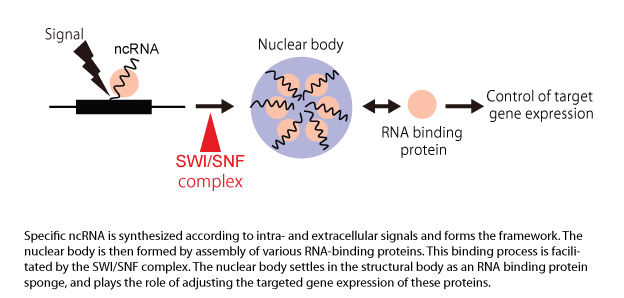Common Mechanism for Non-Coding RNA to Assemble Nuclear Bodies Discovered
Research Press Release | April 15, 2015

| Press Release | ||
|---|---|---|
| Key Points | ・Although there are still many mysteries regarding non-coding RNA1), we discovered a common mechanism which works to assemble the nuclear bodies2).
・Furthermore, we determined that this new function to bind proteins to each other by chromatin remodeling complexes3) is required for this process ・These discoveries are expected to lead to further identification of the causes of neural diseases as well as lead to the development of a foundation for medical therapeutics. |
|
| Overview | Since entering the twenty-first century, a large amount of unidentified non-coding RNA (ncRNA) produced from the human genome has been discovered, and much attention is now being focused on how ncRNA works. Previously in our research, we discovered a type of ncRNA that functions as a framework to support the granular structure (nuclear body) observed within the cell nucleus. This time, we identified the mechanism by which the nuclear body is assembled, and that the protein complex called the SWI/SNF chromatin-remodeling complex (SWI/SNF complex), plays an important role in this mechanism.
The SWI/SNF complex is known to be an important factor in the control of gene expression which changes the chromatin4) structure, and has been often reported to be involved in the development of cancer. However, in this study, we discovered that the SWI/SNF complex is active in the ncRNA-dependent assembly of nuclear bodies—it binds multiple proteins to each other in a previously unknown, new function. This discovery is expected to contribute not only to the understanding of ncRNA activities which are still filled with mystery, but also in the identification of the assembly processes of toxic granules detected in neural diseases. Notes on terminology: 1)Non-coding RNA: RNA molecules which do not contain protein information, but perform other biological functions. 2)Nuclear body: A particle structure existing within the cell nucleus. Mainly works as a site to control gene expression, and a site for synthesis and storage of regulatory factors 3)Chromatin-remodeling complex: Contains chromatin-remodeling activities which change chromatin conformation by utilizing ATP energy, and factors in the control of gene expression on the chromatin.4) 4)Chromatin: A DNA and protein complex with genetic information, which is folded in the nucleus in a complex manner. Can be detected as a chromosome during cell division. |
|
| Inquiries |
Tetsurou Hirose, Professor, Institute for Genetic Medicine, Hokkaido University TEL: +81-11-706-6956 FAX: +81-11-706-7540 E-mail: hirose@igm.hokudai.ac.jp |
|
|
Japanese Link |
ノンコーディング RNA が核内構造体を組み立てるための 共通メカニズムを発見 | |
| Publications | SWI/SNF chromatin-remodeling complexes function in noncoding RNA-dependent assembly of nuclear bodies, Proceedings of the National Academy of Sciences USA (2015.3.23) | |
